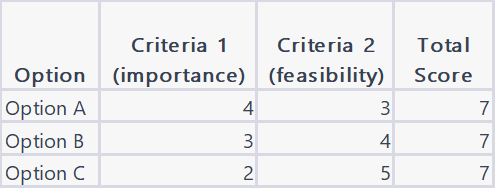How to Use This Example Of A Decision Matrix For Your Business
What is a Decision Matrix
This example of a decision matrix is a guide to the using a decision matrix. It explains how they work and why they are important. The article will help you understand the decision matrix and use it to make decisions. A decision matrix is an analytical tool that can be used when making decisions. It provides a list of alternatives for each possible outcome. The alternatives are ranked in order of their desirability under the assumption that all outcomes are equally possible. The decision matrix was created by Thomas Bayes, who discovered it while trying to solve a problem in probability theory. The decision matrix resources included herein are sufficient for you to create a decision matrix related solution for you own problem.
Making small decisions to make a big decision.

Use This Decision Matrix Template to Solve Your Problems
A decision matrix is a data visualization tool that evaluates and prioritizes a list of options. It is a table that has two dimensions and four cells on each dimension. A decision matrix can be applied to any problems or decisions that has two or more solutions, with one solution being the best option.
The first dimension in the decision matrix represents the different solutions for the problem. The second dimension represents the different things that are being compared in order to determine which solution is best.
The decision matrix is a powerful tool that can be used to make complex decisions. It is a table that lists all the possible outcomes of a decision and the corresponding benefits or drawback of each outcome.
The decision matrix is not only useful for solving complex problems, it also helps people break down complicated tasks into smaller steps and make better decisions in their lives.
A decision matrix is a tool that can be used to make better decisions faster. It helps to determine the possible outcomes and their net results.
A decision matrix can be used to compare different products or services such as cars, laptops, TV shows, etc., or it can be used to rank different ideas for marketing campaigns, new product features, etc.
How the Decision Matrix Fits into the Five Step Decision Making Model
A decision matrix is a tool that helps us to make better decisions. It is an easy way to compare our options and make a decision.
The process of decision making starts with defining the problem we are trying to solve. Next, we need to identify the criteria that will be used for the evaluation of each possible solution. The next step is identifying all possible solutions and their corresponding scores for each criterion. The decision matrix is then used to compare the solutions by evaluating them according to our chosen criteria and selecting the best one in accordance with our preferences.
Decision Making Model in Five StepsUse These Decision Matrix Resources in Business Decision Making
A decision matrix is a tool that helps you make decisions more easily. It is used in business decision-making and can be applied to both small and large scale decisions.
Decision matrices are often used to simplify the process of making a decision when there are many variables involved. The matrix lists out all the possible options and their respective pros and cons. You then use this information to decide which option is best for your company based on what you want your company’s goals to be.
We can use a decision matrix when we need to make business decisions with various factors at stake, such as:
- Which new product should we launch?
- Should we hire additional staff?
- Should we invest in this new technology?
The Different Types of Decisions You Can Make with a Decision Matrix Related Approach
Decision matrices are a type of decision-making tool that is used to compare the advantages and disadvantages of two or more courses of action.
A decision matrix can be used in many different situations. It can be used in business, marketing, finance, and other areas to help make decisions. It includes a list of features on the left side and a list of rankings for each alternative on the right side. The matrix is then filled out with information that helps show how each feature affects the outcome.
The Pros and Cons of Using
a Decision Matrix in Your Business
This decision matrix method is a tool that helps people in the business world make decisions by weighing the pros and cons of an issue. It is a useful tool for any company to have, but it is not always necessary to use.
Pros:
- Helps people make decisions by weighing the pros and cons of an issue.
- A useful tool for any company to have.
- Allows people to compare different options, as well as their respective strengths and weaknesses, at one glance.
Cons:
- Not every business needs a decision matrix because they may not be able to afford one or they don't have many complex decisions that need to be made each day.

How to Use the Decision Matrix Table to Make a Decision
The decision matrix example below is a decision matrix template that can be used for your own decision making. You can first learn how it works with the filled in example. It is constructed so that you can input your own factors that effect your decision making process. You can change the alternatives, the titles and the weights. So anything that is in a gray box can be changed with your own opinion numbers. In the matrix results on the right column, you will get results that tells you what decision to make. The bottom row lets one supply weights for the various criteria. If one factor is twice as important as other factors, you would assign it a weight of 2. It is a decision matrix that you can use over and over again. This is a way to chose between alternatives as outlined in Decision Making Model In Five Steps.
There is even a button to let you print out the results.
Along the left hand side of the decision matrix table are listed all of the your possible decision alternatives. Next enter the determining factors that you are interested in along the top of the matrix decision grid. You then need to decide the weight for each factor. The example shows safety risk as a 4 and management difficulty as a 2. This means that you feel that safety is twice as important a factor as management difficulty. The final entries are for your opinion (scale of 1-10) of what your opinion is of how a given factor affects a given alternative. Remember that negative factors are opposite. This means that for a negative factor such as safety risk, high numbers mean low risk. For a positive factor such as stability, high numbers mean high stability. The winner is the highest matrix criteria rating in the totals column. You still may have to decide between 2 or more alternatives whose totals are the same or very close. However, you will have eliminated a whole lot of less desirable alternatives.
Start With an Unweighted Matrix
It is best to start with an unweighted decision matrix. When you begin to understand that one factor has a higher importance than another factor you can go to a weighted decision matrix. How much that weighting should be must be carefully evaluated.
Summary
This example of a decision matrix gives you a logical approach to analyzing your decision alternatives. It is designed to give you full flexibility in developing a logical approach and printing your result.
Note: This rational decision making model is sometimes called the Pugh matrix decision model.
Q: Can you provide an example of a decision matrix for business or marketing decision matrix?
A: A decision matrix for business can be used to help evaluate and rank various options in a variety of marketing and business contexts. The following is a straightforward illustration of a marketing decision matrix:

Based on the scores, options A, B, and C all receive the
same total score of 7. On the other hand, the scores for each criterion can be
used to further evaluate and rank the options. If "importance" is
thought to be the most important factor, for instance, option A would be the
best option. If, on the other hand, "feasibility" is more important, then
option B is the better choice. Weighting
of each of the criteria would simplify the analysis.
This is only a small illustration; Any number of options and criteria that are relevant to the decision being made can be included in a decision matrix.
How Business Analyst Can Use Decision Matrices to Make Tough Decisions